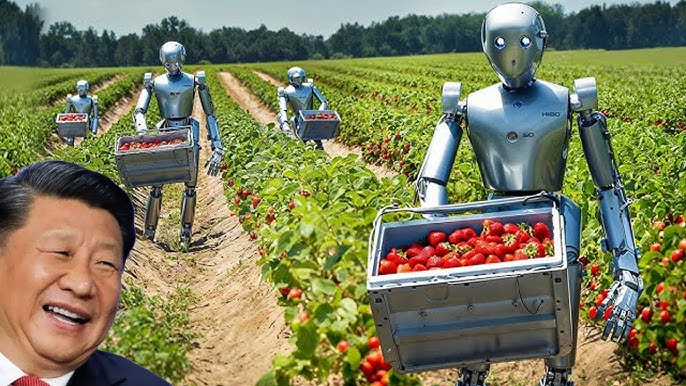KAZI ABUL MONSUR,JOURNALIST#
China is leading a quiet yet impactful agricultural revolution, combining its deep-rooted farming traditions with cutting-edge technology to create a sustainable and resilient agricultural model. Despite being a global industrial powerhouse, the country has not abandoned its agricultural roots, instead modernizing the sector to secure its food supply and support global demands.
According to data from the National Bureau of Statistics of China, the country is set to produce approximately 700 million tons of grain in 2024, marking a 1.6% increase compared to 2023. After nine consecutive years of averaging 650 million tons annually, this is the first time China has achieved a record milestone of 700 million tons of grain production.
Despite agriculture’s contribution to the national GDP dropping to 7.1% in 2023 from around 80% in the 1960s, the country has made significant strides in science and technology. Presently, the industrial sector contributes 38.3% to China’s GDP, while the service sector accounts for 54.6%.
Record Grain Output in 2024
According to China’s National Bureau of Statistics, the country achieved a record grain production of 700 million tons in 2024, marking a 1.6% increase from the previous year. This milestone comes after nearly a decade of maintaining an average annual grain output of 650 million tons, showcasing the success of advanced farming techniques and innovative policies.
Technology-Driven Agriculture
China has embraced modern technologies such as AI, drones, and IoT in its farming practices. These advancements have enabled precision farming, efficient irrigation, and pest control, significantly boosting crop yields. The development of climate-resistant crop varieties has further reinforced the nation’s food security in the face of global climate challenges.
Balancing Tradition and Progress
While urbanization has transformed China into a global manufacturing hub, rural farmers continue to uphold the country’s agricultural heritage. The government has supported this balance through subsidies, technological training programs, and investments in sustainable practices.
Economic Contributions
Agriculture contributes only 7.1% to China’s GDP, a sharp decline from the 80% seen in the 1960s. However, it remains critical for rural livelihoods and plays a significant role in global food trade. In 2024, China exported $3.2 trillion worth of goods, including agricultural products, underscoring its importance as a global supplier.
Challenges on the Horizon
Despite its success, China faces challenges such as soil degradation, climate change, and an aging rural workforce. The government is addressing these issues through land restoration projects, education programs, and incentives to retain younger generations in farming.
Global Leadership in Agriculture
China’s investments in global agricultural projects, particularly under the Belt and Road Initiative, have extended its influence in developing countries. However, critics argue that such investments may create long-term financial dependencies.
Alongside advancements in science and technology, Red Giant China has ushered in a silent revolution in food production and the agricultural sector. While becoming a global hub for industrial and manufacturing activities, the Chinese people have not entirely abandoned their traditional farming practices. Today, the nation is pioneering a new era in agriculture by integrating modern technology and innovative ideas.
Economic Challenges and Foreign Reserves
China’s economy has faced challenges amidst the ongoing global economic downturn. Yet, over the past decade, the country has maintained its position as the world leader in foreign currency reserves. According to recent data from Wikipedia and the State Administration of Foreign Exchange of China, as of November 1, 2024, China’s foreign reserves stood at $3,380.4 billion, underscoring its robust economic capabilities.
Trade Recovery Amid Global Tensions
China’s foreign trade suffered setbacks in 2023 due to ongoing economic and trade disputes with the United States. However, by late 2024, the country showed remarkable recovery. Reports from China’s General Administration of Customs indicate that between January and November 2024, the nation’s total foreign trade (imports and exports) amounted to $5.49 trillion, compared to $5.87 trillion in 2023 and $6.05 trillion in 2022.
In the first 11 months of 2024, China exported $3.2 trillion worth of goods and services while importing $2.3 trillion. This contrasts with 2023, when exports totaled $3.38 trillion and imports $2.56 trillion, marking declines of 4.6% and 5.5% respectively compared to 2022.
Economic Comparisons with Global Powers
According to updated 2024 data from Wikipedia and the IMF, the United States remains the world’s largest economy with a GDP of $29.168 trillion, followed by China with a GDP of $18.274 trillion. The IMF predicts a GDP growth rate of 2.8% for the U.S. and 4.8% for China in 2024. As of June 2024, China’s total external debt stood at approximately $2.545 trillion.
Criticism of China’s Foreign Debt Policy
Western media often criticize China’s foreign debt and investment policies, particularly their impact on low-income countries. These policies are seen as creating economic challenges for these nations, often trapping them in so-called “invisible debt traps.” Between 2013 and 2022, under the Belt and Road Initiative, China provided $679 billion in loans to 150 countries, many of which struggle to repay. However, China dismisses much of this criticism as biased and flawed. ##Sources: U.S. Government Accountability Office, CMG Bangla, IMF, China Customs, Reuters, and Wikipedia.



মন্তব্যসমূহ বন্ধ করা হয়.